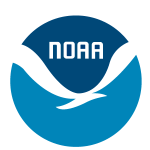- Industry: Government
- Number of terms: 30456
- Number of blossaries: 0
- Company Profile:
NOAA Coral Reef Conservation Program, National Oceanic and Atmospheric Administration, U.S. Department of Commerce
An apparatus that uses sound waves to detect objects underwater by measuring or classifying the echoes received from them. An echo sounder is a sonar that transmits vertically. In practice, a sonar is an apparatus other than an echo sounder, i.e. a sonar transmits horizontally.
Industry:Fishing
Any part of the water column between the surface and the seafloor. Fish living at the surface or on the seafloor do not live in midwater.
Industry:Fishing
1. In a sole ownership fishery, the difference between the total revenues obtained from the fishery resource and the total costs of production, i.e. capital and labor valued at their opportunity costs. The total costs of production include a reasonable profit and the rent is often considered as a "surplus" profit, over and above what would be considered a 'normal' rate of return. For this reason, the decision as to who gets the rent (e. G. society, the management authority, or the fishermen) remains a key policy issue; 2. Any payment to an owner of a productive resource that is an amount in excess of the payment needed to keep the resource in its current use. Applied to fisheries, the amount of pure profit that can be gained from a fishery resource by using no more fishing effort than needed to harvest the resource. Under open access, the resource would yield no economic rent, whereas a sole owner would seek to maximize economic rent.
Industry:Fishing
A process of evaluation including the identification of the attendant uncertainties, of the likelihood and severity of an adverse effect(s)/event(s) occurring to man or the environment following exposure under defined conditions to a risk source(s). A risk assessment comprises hazard identification, hazard characterization, exposure assessment, and risk characterization.
Industry:Fishing
All water naturally open to the atmosphere, including rivers, lakes, reservoirs, streams, impoundments, seas, estuaries, and so on. The term also covers springs, wells or other collectors of water that are directly influenced by surface waters.
Industry:Fishing
Date established for defining the pool of potential participants in a given management program. Control dates can establish a range of years during which a potential participant must have been active in a fishery in order to qualify for quota share.
Industry:Fishing
A process in which a protected area is divided into discrete zones and particular human uses of each zone is permitted, often with conditions such as gear limitations in fishing and waste discharge prohibitions in tourism.
Industry:Fishing
1. Ability to target and capture fish by size and species during harvesting operations, allowing bycatch of juvenile fish and nontarget species to escape unharmed; 2. In stock assessment, conventionally expressed as a relationship between retention and size (or age) with no reference to survival after escapement.
Industry:Fishing
A breakdown of different age groups of fish, showing the decrease in numbers of fish caught as the fish become older and less numerous or less available. Catch curves are often used to estimate total mortality.
Industry:Fishing
A device inserted in a fishing gear (usually trawl nets, close to the codend) to allow escapement, alive, of unwanted (nontarget and prohibited) species (e.g. jellyfish), smaller fish (juveniles), and threatened or endangered species (e.g. sea turtles, marine mammals).
Industry:Fishing
